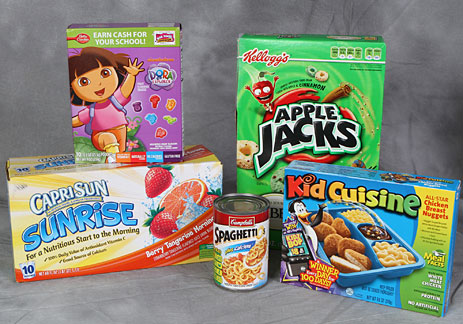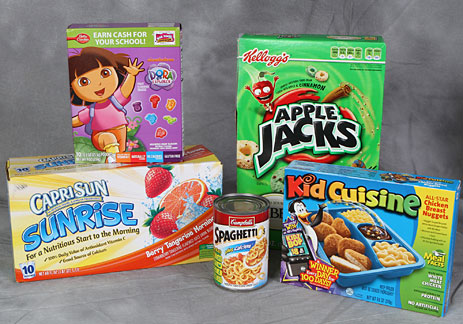 E tu, Dora?: The worst offenders of the studyPhoto: PreventionInstitute.orgAnyone who followed the fracas over the food industry’s now abandoned “Smart Choices” label — the “healthy food” label that somehow allowed products like Froot Loops to qualify — should have realized that Big Food can’t resist the temptation to stretch the truth when it comes to front-of-package labeling. But a new study released today by the California-based Prevention Institute should represent the final nail in the coffin of the corpse that is food industry self-regulation.
E tu, Dora?: The worst offenders of the studyPhoto: PreventionInstitute.orgAnyone who followed the fracas over the food industry’s now abandoned “Smart Choices” label — the “healthy food” label that somehow allowed products like Froot Loops to qualify — should have realized that Big Food can’t resist the temptation to stretch the truth when it comes to front-of-package labeling. But a new study released today by the California-based Prevention Institute should represent the final nail in the coffin of the corpse that is food industry self-regulation.
The “Claiming Health: Front-of-Package Labeling of Children’s Food” [PDF] study examined over 50 products that food companies advertise as their healthiest for children — “Smart Choices” was but one front-of-package label of many others still in use. In the spirit of fairness, the study authors didn’t go looking for crap food: they selected products from an industry-created list that was part of its own “Children’s Food and Beverage Advertising Initiative,” which selects products the industry has itself determined to meet good nutritional standards. From that list, the study authors then selected products with some type of “healthier for you” front-of-package labels and analyzed them using nutritional standards based on the National Academy of Science’s 2005 “Dietary Guidelines for Americans.”
The researchers concluded that in fact, 84 percent of those products did not meet these basic nutritional standards.
Some highlights:
- More than half (57 percent) of the study products qualified as high sugar, and an astonishing 95 percent of products contained added sugar.
- More than half (53 percent) were low in fiber.
- More than half (53 percent) of products did not contain any fruits or vegetables; of the fruits and vegetables found, half came from just two ingredients — tomatoes and corn.
- 24 percent of prepared foods were high in saturated fats.
- More than one-third (36 percent) of prepared foods and meals were high in sodium.
Keep in mind, these are not simply foods marketed to children. These are foods advertised as healthy for kids!
It doesn’t seem unfair to suggest that “healthy” foods should be those that have low or no sugar, for example. Another point made within the study is that one-fifth of all the foods studied — including 50 percent of snacks and 40 percent of breakfast cereals — included artificial colors, whose health effects are becoming ever more controversial. You don’t have to be convinced (as Europe, the state of Maryland, and I admittedly am) of the risks of artificial colors to agree that perhaps foods with them shouldn’t qualify as particularly healthy.
This study is particularly relevant because the FDA is in the middle of determining new standards for front-of-package labels. One possibility under consideration is the so-called “traffic light” system — already in use in Britain — whereby nutritional benefits or deficiencies in a product are indicated with a green or red light. The industry is up in arms about this possibility because the idea that food labels might be used to convince consumers not to buy something — as has been done with tobacco products — is simply beyond the pale for them. They want to be able to accentuate the positive — as in, touting the fiber in Apple Jacks and ignoring the high sugar. (Yes, Kellogg’s does this).
Nutrition expert Marion Nestle, an expert on these matters, has come to believe that the process is hopelessly flawed and the FDA should simply ban front-of-package health labels of any kind. And given the weak-kneed fainting spells so common in the halls of the FDA whenever industry complains, her logic is compelling.
Yet I doubt the FDA will choose that route. So, as a compromise, even if we acknowledge the food industry’s right to be freed from negative labels on its products, at a minimum the FDA should be able to require a set of reasonable standards that a product must meet before any one positive element can be highlighted.
Either way, it’s clear that the food industry never fails to miss an opportunity to miss an opportunity. Even by their low standards, their front of package labeling has to be considered a massive FAIL.




